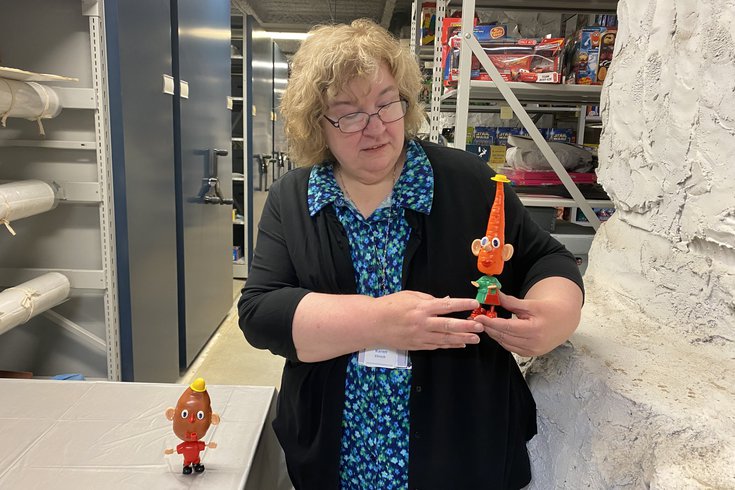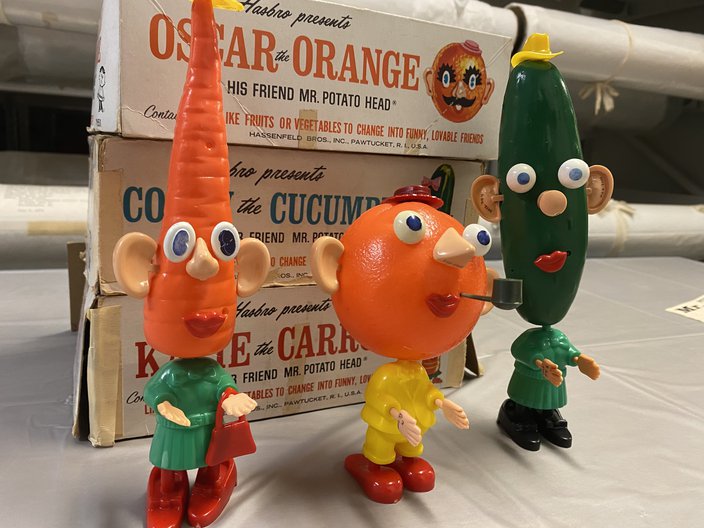
October 05, 2023
 Kristin Hunt/PhillyVoice
Kristin Hunt/PhillyVoice
Karen Elinich, the museum's senior director of research & impact, holds Katie the Carrot, one of four 'friends' made for Mr. Potato Head in the 1960s.
Mr. Potato Head's most famous companion is his wife of 70 years, the red-lipped Mrs. Potato Head. But way back in the '60s, he hung out with a motley crew of plastic vegetables and fruits that are now mere legends in toy history.
In 1964, Hasbro introduced Katie the Carrot, Oscar the Orange, Pete the Pepper and Cooky the Cucumber as "friends" of Mr. Potato Head, who came in each of their boxes. Kids could mix and match pieces no matter which produce they chose, trading ears, noses, hats and handbags among the figures. Despite their versatility, Mr. Potato Head's pals wouldn't survive the '70s and now, they're collector's items hawked by eBay, Etsy and other sellers.
That's how the Please Touch Museum got its hands on three of the four friends — Katie, Oscar and Cooky — who now reside in the stacks of the children's museum in Fairmount Park near West Philly's Parkside neighborhood.
"I think like a lot of the toys from the '60s, especially the early '60s, they are really colorful," Karen Elinich, senior director of research and impact for the museum, said. "Very indicative of sort of American childhood at that time with a lot of positive energy. But a lot of the toys from that time tend to be not the easiest for kids to play with."
As four adult women huddle over the figurines, trying to keep their accessories screwed in place and their bodies from tipping over, it's clear Elinich has a point. But Mr. Potato's Head's lengthy history has been marked by several evolutions to make the toy more accessible to children, starting with the brand's first major redesign and expansion in 1964.
Katie the Carrot, Oscar the Orange and Cooky the Cucumber stand in front of the boxes.
It's a metamorphosis the Please Touch Museum can appreciate. While the interactive shrine to childhood and play has been in Philadelphia for 50 years, it only stepped into its current location at 4231 Avenue of the Republic in 2008, transforming a historic space that had fallen into disrepair.
The building was once Memorial Hall, an art gallery built for the first world's fair in the U.S. in 1876. After that expo, it functioned as a museum, then became a recreation center with an Olympic-size swimming pool. It had been forgotten and vandalized when renovations began to turn it into the sprawling kids' museum with 25,000 artifacts in its collection.
That collection includes several iterations of Hasbro's signature spud, who debuted in 1952 to immediate success. Mr. Potato Head's quick popularity was thanks in part to a pioneering marketing campaign. He was the first toy advertised on television, with a commercial tailored to its actual audience.
"It is the first product for children that has an ad that speaks to children," Elinich said. "Typically, before that, children's products were advertised to the parent, to the buyer. So the fact that kids are seeing this commercial and seeing it presented to them in a way that's familiar to them makes this thing a hot potato."
But he was also little more than a heap of plastic ears and eyes. Kids — or, more accurately, their parents — were expected to provide their own potatoes, stabbing the spuds (or whatever was left in the crisper) with their appendages to make a "funny face." Since the pieces had to slice into actual produce, the metal prongs were fairly sharp, making Mr. Potato Head a downright dangerous toy.
"Of course a kid stabs himself or herself trying to put the ears in," Elinich said. "So they get some blood on this potato, and then of course they toss it aside where it starts to grow eyes and mold."
Parents didn't love the injuries or the wasted groceries, so in 1964, Hasbro redesigned the toy. Mr. Potato Head reemerged with a plastic body, about the size of a small potato, and four brand new friends. Cooky and Katie were girl veggies, with the traditional purses and dresses to match, while Oscar and Pete came with masculine pipes and hats.
Mrs. Potato Head had already joined the crew in 1953, and none of the new members turned out to have the same staying power as the original couple. Advertisements for Cooky, Katie, Pete and Oscar disappear from newspapers around 1970, as the toys slowly vanished from store shelves. (Hasbro was unable to confirm when the sidekicks were officially discontinued.) They would never return, apart from a slightly sinister Pete the Pepper bobblehead that Funko produced in the early aughts.
It's not clear what hobbled the toys, but their size probably didn't help. The plastic bodies measured just a few inches, and the even smaller accessories could easily slip between fingers.
"By the mid-70s, they've done enough research and discovered that for the early childhood learner their fine motor skills aren't fully developed yet," Elinich explained. "And so trying to put the little accessories into little holes with their little hands is challenging. So the form gets exaggerated in the mid-70s into that shape of the potato head that's very familiar to us."
Hasbro also had not made a key breakthrough in packaging: the window panel. In the '50s and '60s, toy companies typically adorned boxes with hand-drawn illustrations, and kids could not actually see what was inside, making it harder to whip them into a gotta-have-it frenzy.
Katie, Cooky, Oscar and Pete were also, in the end, first drafts in a new era in American history. The idea that families should use disposable income on toys for children, Elinich said, was still fairly new at the tail end of the baby boom in 1964. As was plastic, a material that took off during World War II and brought down the cost of toys, which had previously been made from expensive porcelain or wood. And while Mr. Potato Head was the first toy to star in a TV commercial, he certainly wouldn't be the last, especially as pioneering children's shows like "Sesame Street" and "Mister Rogers' Neighborhood" kept kids glued to the dial.
"I think they are very much of their time," Elinich said of the forgotten toys. "These characters, they're clever, they're fun, they're colorful, they have distinct characterizations, but yet they're really not the best choice."
Follow Kristin & PhillyVoice on Twitter: @kristin_hunt
| @thePhillyVoice
Like us on Facebook: PhillyVoice
Have a news tip? Let us know.
 Kristin Hunt/PhillyVoice
Kristin Hunt/PhillyVoice